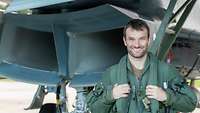German Eurofighters protect multinational aircraft carrier force
Indo-Pacific- Date:
- Place:
- Hawaii
- Reading time:
- 4 MIN


The RIMPACRim of the Pacific 2024 naval exercise with approximately 40 ships, 25,000 participants and 44 fighter jets will be joined by three Eurofighters and one A400M transport aircraft of the German Air Force. Lieutenant Colonel Marco Brunhofer of 73 Tactical Air Wing “S” based at Rostock/Laage leads the German contingent and provides an insight into cooperation with the naval forces involved.

Lieutenant Colonel Brunhofer of 73 Tactical Air Wing “S” based at Rostock/Laage leads the German Air Force contingent during the Rimpac exercise in the Pacific. The contingent consists of three Eurofighters and one A400M.
Bundeswehr/Daniel FuchsAs contingent commander, I will command the German aircraft both during the exercise and on the outward and return flight and will fly a Eurofighter jet myself. In addition, I am strongly involved in the planning of the exercise and participate, for example, in coordination meetings with the German Navy and our international partners.
This is the first time that we will participate in the biennial Rim of the Pacific (RIMPACRim of the Pacific) exercise in the Indo-Pacific region. We benefit from the fact that exercise control will be assumed by the USUnited States and that many of the participants are NATONorth Atlantic Treaty Organization partners, who all speak the same language. Still, this joint exercise remains something special and challenging for all parties involved.
We will fly with three Eurofighter and two A400M aircraft from Japan to the USUnited States (United States) military base at Pearl Harbor (Hawaii). We will fly for as many as 10.5 hours without interruption, which will be a new record for German Eurofighters. To ensure that we do not run out of fuel en route, we will be refueled by USUnited States tanker aircraft during flight.
On site, we will then practice with the three fighter jets and an A400M, which will be used to refuel both our own and allied aircraft. Unlike the USUnited States (United States) Navy jets, we cannot land on the USUnited States aircraft carrier “USSUnited States Ship Carl Vinson”. Instead, we have to rely on dependable air refueling in the large exercise area. With a total of only 50 service members, we will showcase our ability to quickly fly to far-off locations with a limited number of personnel and multiple aircraft and to demonstrate our combat effectiveness there.
Participation in the RIMPACRim of the Pacific naval exercise does not take place in a vacuum but is embedded into the Pacific Skies exercise, which in turn breathes life into the Indo-Pacific strategy adopted by the German government. Together with the German Navy, we will demonstrate our joint ability to conduct operations in far-away regions. The combination of Air Force and Navy is indispensable in the Indo-Pacific. Thus, to achieve success we need to take a comprehensive approach. Though we have, of course, already completed exercises with the Navy over the North and the Baltic Sea, the training situations to be faced in the Pacific will be totally different. The challenge here lies above all in coordinating space and time so as to ensure that everyone will be in the right place at the right time. While the Air Force is able to fly quickly from A to B, the Navy cannot deploy in such a short time. Then again, a ship does not depend on airfields and tanker aircraft.
Training in the exercise area will consist of two parts. From 27 to 30 July, we will participate in the RIMPACRim of the Pacific naval exercise. Among other things, we will be integrated into a multinational aircraft carrier force that is to protect the American aircraft carrier “USSUnited States Ship Carl Vinson”. In varying scenarios, we will practice both protecting the aircraft carrier against enemy fighter aircraft and attacking these enemy fighter aircraft. In addition, we will simulate an attack on enemy forces on a group of islands with numerous radar positions. For this purpose a COMAO, a Composite Air Operation, will be planned and conducted. We will not be doing this alone but together with aircraft of the USUnited States (United States) Navy, the USUnited States (United States) Air Force, the USUnited States (United States) Marines and other partners.
After the naval exercise, we will practice dogfights, i.e. air-to-air combat similar to that in the movie Top Gun, with the Hawaii Air National Guard from 31 July to 5 August.
For one, there is the large distance between the exercise area and our parent unit, 73 Tactical Air Wing “S”. In order to ensure operational readiness on site, we will carry as many spare parts as possible in our two transport aircraft. If yet more are needed, there will be a deployment package in Australia, which contains a much greater amount of equipment. Apart from that, due to the monsoon season the weather may also prove to be a challenge and we might have to factor in the possibility of hurricanes.
by Cedric Kortenbruck